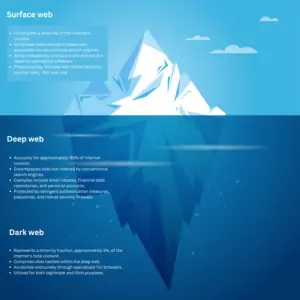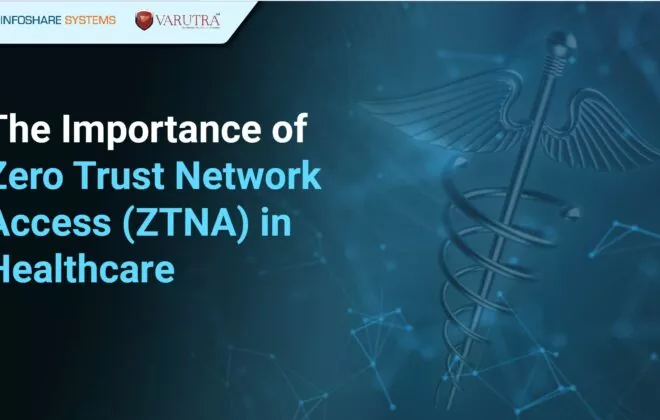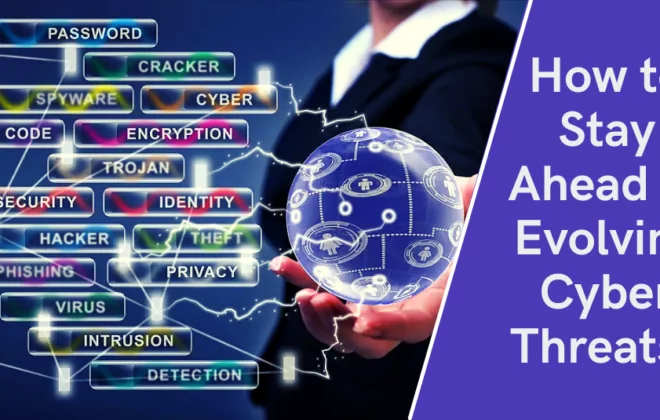The Hidden Internet: Exploring the Secrets of the Dark Web
Introduction
The internet, often regarded as a vast and mysterious realm. It is not a singular entity but rather a complex ecosystem with distinct layers waiting to be uncovered. In this significance, we embark on a journey to unravel the three fundamental divisions of the internet: the Surface Web, the Deep Web, and the enigmatic Dark Web . Each layer holds its secrets, opportunities, and challenges, offering a multifaceted view of the digital world.

The surface web consists of websites and webpages openly accessible to the general public through standard web browsers like Google Chrome, Firefox, or Safari. It is the virtual realm where most of our daily online activities take place. When we explore the Surface Web, we can imagine searching for our favourite restaurant’s menu, catching up on the latest news, or connecting with friends on social media platforms. These experiences all occur on the Surface Web, where information flows openly and user identities are firmly established. It is
the tip of the internet iceberg, easily explored and interacted with, making it a familiar terrain for users worldwide.
II. What is Deep Web?
The deep web refers to a vast portion of the internet that is not indexed by standard search engines like Google, Bing, or Yahoo. It is essentially the part of the World Wide Web that is hidden from public view and is not easily accessible through regular web browsing. The deep web consists of web pages and content that are not indexed for various reasons, including privacy, security, or simply because they are behind paywalls or login screens.
Key characteristics:
Unindexed Content: Deep web content is not catalogued by search engines, so we can’t find it through typical search queries. This includes databases, private websites, academic research, and more.
Password-Protected and Secure Pages: Some deep web content is behind password-protected areas or encrypted connections, making it inaccessible without proper authorization.
Dynamic and Non-HTML Content: Content generated dynamically in response to user input, such as online banking or e-commerce transactions, is often part of the deep web. Additionally, non-HTML file formats like PDFs, images, and videos may not be indexed.
Private and Subscription-Based Services: Subscription-based websites, email services, and private forums are part of the deep web because they require user authentication to access them.
Legal and Non-Sinister Content: The deep web isn’t inherently threatening; it also includes legal and legitimate content such as academic research databases, medical records, government databases, and confidential business information.
III. Is the Dark Web Really Dark?
The Dark Web, that hidden corner of the internet, holds many surprises. Dr. Michael McGuire’s 2019 study revealed a 20% increase in Dark Web listings since 2016, shedding light on the growing activity in this secretive realm. Imagine purchasing a cloned credit card with a PIN for as low as $25; it’s just one example of the shady deals happening here. It’s important to understand that the Dark Web is a small part of the Deep Web, which constitutes 90% of the internet.
The Dark Web has expanded dramatically since 2017, driven by the rise of cryptocurrencies. However, beware, as 60% of the content here could harm businesses, with data breaches and stolen information rampant.
In contrast to the Surface Web, the Dark Web is a concealed world that remains hidden from traditional search engines. Its obscurity earned it the “dark” label, but not everything within is nefarious. The concept of the Dark Web emerged in 2006, primarily serving as a haven for anonymity in government and political communications. It provided a digital refuge where individuals could protect their identities in an increasingly interconnected world.
To access the Dark Web’s hidden corners, specialized software is necessary. Tor, short for “The Onion Router,” allows users to navigate the Dark Web anonymously by routing online traffic through a network of servers distributed across the globe, hiding users in a veil of digital invisibility. While the pursuit of anonymity may result in reduced network speeds due to delays, it remains a vital feature of the Dark Web’s architecture.
a. Anonymity on the Dark Web
Anonymity is one of the primary advantages offered by the Dark Web. By concealing personal information like location and IP address, users can operate in the shadows, shielded from prying eyes.
The Dark Web employs robust encryption techniques and layered routing, adding layers of protection to users’ privacy. These safeguards ensure that online activities remain confidential, shielding personal information from surveillance and data collection by governments, corporations, or malicious actors. Furthermore, the Dark Web is not solely a den of evilness; it houses legitimate websites and forums addressing subjects such as cybersecurity, cryptography, and privacy. For researchers and scholars, this digital space offers a wealth of academic resources and a platform for exploring emerging technologies and digital trends.
b. The Dark Web’s Dark Reputation
However, the Dark Web’s shadowy reputation is not entirely unfounded. It indeed hosts illegal activities, making it a breeding ground for cybercriminals. The cloak of anonymity and encryption becomes a haven for individuals engaging in illicit endeavours. It serves as an untraceable platform for various criminal activities, beyond the reach of traditional law enforcement and cybersecurity measures.
One prominent facet of the Dark Web is its illegal marketplaces, where individuals can engage in transactions involving illicit goods and services. Stolen documents, hacker-for-hire services, drugs, weapons, counterfeit documents, and hacking tools are among the commodities traded in these clandestine markets. Cryptocurrencies are the preferred mode of transaction, adding an additional layer of anonymity to these nefarious dealings. Stolen data, encompassing credit card information, login credentials, medical records, and personal details, is frequently traded on the Dark Web. Cybercriminals acquire this information through hacking, phishing, or other illicit means, subsequently selling it to interested buyers for purposes such as identity theft and fraud.
c. The Underbelly of Cybercrime
The Dark Web extends its sinister reach by functioning as a marketplace for cyber weapons, zero-day exploits, and hacking tools capable of breaching computer systems and networks. These tools provide individuals with malicious intent the means to launch large-scale cyberattacks, infiltrate organizations, disrupt critical infrastructure, or engage in state-sponsored cyber espionage.
Forums and communities dedicated to financial fraud schemes also flourish on the Dark Web. These encompass the sale of stolen credit card details, tutorials on carding (fraudulent online purchases), money laundering services, and methods for conducting fraudulent activities such as phishing scams and identity theft. Furthermore, the Dark Web offers various services to launch cyberattacks, including hacking tools and malware for sale. These resources empower individuals with malicious intent to target specific entities, compromise systems, steal sensitive information, or hold data hostage for ransom.
IV. Empowerment Through Understanding
In conclusion, the Dark Web represents a paradoxical aspect of the internet. While it is often associated with illegal and unethical activities, it also serves as a sanctuary for individuals under oppressive regimes who rely on secure communication methods. Recognizing the duality of the Dark Web empowers us to navigate the digital world responsibly.
Awareness of the risks and opportunities presented by the Dark Web is crucial for individuals, businesses and law enforcement agencies alike. It underscores the need for responsible internet usage and the importance of working collectively to create a safer online environment. The internet is a powerful tool, and our understanding of its multifaceted nature is key to ensuring it is used responsibly and ethically.
References –
https://medium.com/@kashafibrar9824/unveiling-the-dark-web-an-intriguing-exploration-of-the-hidden-internet-realm-51edf49f91d3
https://www.imf.org/en/Publications/fandd/issues/2019/09/the-truth-about-the-dark-web-kumar
https://infosecwriteups.com/the-dark-web-unveiling-the-underbelly-of-cybercrime-929bee129ed6
https://sopa.tulane.edu/blog/everything-we-should-know-about-dark-web
https://www.csoonline.com/article/564313/what-is-the-dark-web-how-to-access-it-and-what-well-find.html
https://thesecmaster.com/what-is-the-dark-web-revealing-the-secrets-of-the-dark-web/
https://werstory.com/2023/08/dark-web-threats-businesses
https://socradar.io/what-is-the-dark-web-all-about/




